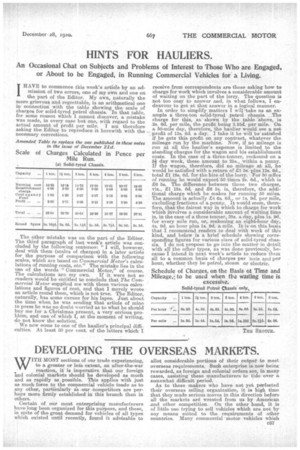HINTS FOR HAULIERS.
Page 23

If you've noticed an error in this article please click here to report it so we can fix it.
An Occasional Chat on Subjects and Problems of Interest to Those Who are Engaged, or About to be Engaged, in Running Commercial Vehicles for a Living.
IHAVE to commence this week's article by an admission of two errors, one of my own and one on the part of the Editor. My own, naturally the more grievous and regrettable, is an arithmetical one in connection with the table showing the scale of charges for solid-tyred petrol chassis. In that table, for some reason which I cannot discover, a mistake was made, in every ease but one, with regard to the actual amount of profit per mile. I am therefore asking the Editor to reproduce it herewith with the necessary corrections.
Amended Table to replace the one published in these notes in the issue of December 21st.
Scale of Charges Calculated in Pence per Mile Run.
The other mistake was on the part of the Editor. The third paragraph of last week's article was concluded by the following sentence: " I will, however, deal with them (scales of charges) in a, later article for the purpose of comparison with the following scales, which are based on Commercial Motor's calculations of running (posts, etc." The mistake lies in the use of the words "Commercial Motor," of course. The calculations arc my own. If it were not so readers would be entitled to conclude that The Commercial Motor eupplied me with these various calculations arid figures of cost, and that I merely wrote an article round them, which is not true. The Editor, naturally, has some excuse for his lapse. Just about the time when, he was Rending that article of mine to press he was no doubt worried as to what he should buy me for a Christmae present, a very serious problem, and one of which I, at the moment of writing, do not know the solution:
• We now come to. one of the haulier's principal difficulties. At least 50 per cent. 'of the letters which I receive from correspondents are those asking how to charge for work which involves a considerable amount of waiting on the part of the lorry. The question is not too easy to answer and, in what follows, I endeavour to get at that answer in a logical manner.
In order to simplify matters I wilrtake as an example a three-ton solid-tyreel petrol chassis. The charge for this, as• shown by the table above, is .2e. 6d. per mile, the profit being 3.25d. per mile. On a 50-mile day, therefore, the haulier would see a net profit of 13s. 6d. a day. I take it he will be satisfied if he gets this profit on any contract, whatever the mileage run by the machine. Now., if no mileage is run at all the haulier's expense IS limited to the standing charges for the wagon and his establishment costs. In the case of a three-tanner, reckoned on a 54 day week, these amount to 25s., within a penny.
,
If the wagon therefore, did no mileage at all, he would be satisfied with a return of 21 5s. plus 13s. 6d., total 21 lEis. fici. for the, hire of the lorry. F Or 50 miles of running he would expect 50 times 2s. 6d., which is 26 5s. The difference between these two charges, viz., 21 18s. 6d. and 26 5s. is, therefore, the additional charge which he makes for running 50 miles. The amount is actually 24 6s. 6d., or 1s. 9d. per mile, excluding fractions of a penny. It would seem, therefore, that the fairest way in which to charge for work which involves a considerable amount of waiting time is, in the case of a three tanner,. 38s. a day, plus Ts. 9d. for every mile run, or, reckoningan eight-hour day, 4s. 9d. an hour plus Ts. 9d. a mile. It is-on this basis that I recommend readers to deal with work of this kind, and below is a brief schedule showing corresponding figures for various sizes of solid-tyred chassis. I do not propose to go into the matter in detail with all the other types, as was done previously, because I intend in next week's article to reduce them all to a common basis of charges per mile and per hour, whether they be petrol, steam or electric.
Schedule of Charges, on the Basis. oi The and Mileage, 1 to be used when the waiting time is






























